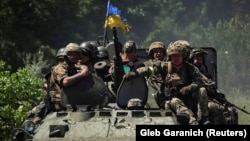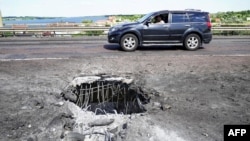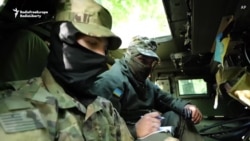The first thing to know: Long convoys of Russian military trucks, tanks, towed artillery, and other weapons are moving away from Ukraine’s Donbas region, headed southwest -- and in at least one case, headed northwest from the Russian-occupied port of Mariupol.
The second thing to know: Bridges, ammunition depots, and rail links are being targeted with growing frequency in Ukraine’s southern regions, hit by Ukrainian forces with powerful Western-supplied weapons.
The most important thing to know: Russia’s war on Ukraine is about to enter a new phase, if it hasn’t already, with the heaviest fighting shifting to a roughly 350-kilometer front line stretching southwest from near Zaporizhzhya to Kherson, paralleling the Dnieper River.
The fight for the city of Kherson alone “could prove decisive in determining the ultimate outcome of the war,” according to at least one account.
“The south is key,” said Peter Zwack, a retired U.S. Army general who served as defense attache at the U.S. Embassy in Moscow.
“It’s more than just a test, from Kyiv’s perspective,” he told RFE/RL. “The fight in the south is existential. Certainly [the Ukrainians] are refining their forces, bringing in new men, equipment, but first and foremost, it’s existential. They’ve got to get the Russians out of the south now -- before everything hardens, coalesces, they’ve got to push them out.”
Already, Ukrainian officials are pointing to a growing number of villages and towns in the Kherson region that have been recaptured. The region’s head, Dmytro Butriy, said on national TV on August 2 that 53 settlements there had been recaptured since the start of the invasion – nine of them over the previous 24 hours.
Ukrainian commanders said that Russian forces were massing in the south in preparation for an assault -- possibly in response to, or anticipation of, Ukraine’s counteroffensive.
Ukrainian artillery and long-range rockets have also hit a growing number of targets of strategic importance to Russia in the Kherson region, including bridges, and more recently, a railroad spur that links it to Russian-occupied Crimea.
“You all have been reporting on the advances that the Ukrainians are making around Kherson -- and we have seen [them],” a senior U.S. Pentagon official said last week, “and they're not large, giant advances but they are certainly advances against the Russians.”
“I don't know if it's a part of a counteroffensive,” the official said at a briefing for journalists. “I know they're making offensive gains. And they are doing so, you know, against a Russian force that…looks like they are ill-prepared for it.”
First To Fall
In the first weeks after Russia invaded on February 24, much of the fighting was concentrated in the north, near Kyiv, and in the south along the Sea of Azov coast, around Mariupol. Ukraine won in the north, driving Russian forces back across the border. Russia made substantial gains in the south, including seizing Kherson, which had a pre-invasion population of around 300,000 and was the first major Ukrainian city to be taken. Mariupol was captured after a brutal siege.
The focus then shifted east, to the Donbas, where Russia regrouped and then pummeled Ukrainian troops with withering artillery and rocket fire and brutal urban warfare. Ukrainian forces were forced to retreat. Russia seized major Luhansk region cities, before taking an “operational pause.”
In the south, however, for weeks, Ukrainian forces have made small, incremental gains in the Kherson region, which straddles the Dnieper. The river has been a natural defensive barrier, and the advances Ukrainian forces have made have been on the northern side, or right bank.
Now, according to military experts, eyewitness reports, social media accounts, and Western intelligence, both Ukraine and Russia are girding for a new concentration of fighting along the Dnieper.
In the Kherson and Zaporizhzhya regions, Russia’s southern grouping is built around the 49th Combined Arms Army, along with mechanized and paratroopers brigades as well as some units that have been mobilized from the occupied parts of the Donetsk and Luhansk regions.
Ukraine’s military intelligence agency said on August 2 that a new battalion tactical group, which comprises between 800 and 1,000 troops, had deployed to Crimea and would be sent into the Kherson region in the coming days.
Russian positions on the northern bank of the Dnieper were untenable and vulnerable, according to Mykola Byelyeskov, a research fellow at the National Institute for Strategic Studies, a Ukrainian government think tank. That’s due in large part to Ukraine’s use of U.S.-supplied M142 High Mobility Artillery Rocket Systems, known as HIMARS.
Russian troop movements are to be expected, Byelyeskov told RFE/RL, given all the signals pointing to a Ukrainian counteroffensive.
“It would be strange for them not to respond to the declared -- in broad terms -- possible [Ukrainian] counteroffensive, with some measures to strengthen their grouping,” he said in a text message. “But movement as such doesn’t solve this [Russian] predicament when their grouping of forces on the right bank of [the] Dnieper depends on bridges” threatened by Ukraine’s artillery.
Last week, three key Dnieper bridges, including the Antonivskiy Bridge, were heavily damaged and rendered impassable by Ukrainian fire. Russia has rushed to repair the bridges, and has installed a temporary pontoon ferry, to allow for men and equipment -- and civilians -- to cross the river.
'A Major Test'
The importance of the Kherson and Zaporizhzhya regions comes from their geography, first and foremost. The largely flat expanse has vast farm fields and power plants. And, as it stands now, Ukrainian lands occupied by Russian forces include the entire Sea of Azov coast, the Crimean Peninsula, and the Black Sea coast up to the mouth of the Dnieper, west of the isthmus that links mainland Ukraine with Crimea.
That puts Russia dangerously close to blocking the entirety of Ukraine’s coastline.
The uptick in the tempo in fighting, and troop movements, may also stem from the Kremlin’s intentions.
Russian officials have signaled plans to hold referendums in the two regions, possibly with an eye toward annexing them, similar to what happened in Crimea in 2014. Already, Russia has installed puppet administrations, started handing out Russian passports, and imposed the ruble as the local currency in place of the hryvnya.
To that end, Ukraine may be pressing forward to thwart Russian referendums that Moscow would use to cement its control, experts said.
While Ukrainian forces have gone toe-to-toe with Russian adversaries in the Donbas for months now, Kherson and Zaporizhzhya will showcase how much Ukrainian troops have learned since February.
Russian troops as well.
“Yes, it will be a major test of Ukraine's military capability,” said Nick Reynolds, a land warfare analyst at the Royal United Services Institute, a London think tank. “So far they haven't been able to successfully counterattack in depth except where the Russian military have conducted discretionary withdrawals to consolidate their forces.”
Ukrainian commanders are also likely to try and seize the initiative when Russian troops are still replenishing and reshuffling forces, Richard Moore, the head of the British foreign intelligence agency MI6, said last month.
The Russians are "about to run out of steam," he told the Aspen Security Forum.
“It’s important to the Ukrainians themselves that they demonstrate their ability to strike back and that will be very important for their continuing high morale,” Moore said. “I also think it will be an important reminder to the rest of Europe that this will be a winnable campaign for the Ukrainians.”
Ukraine Tested, Russia Tested
A new counteroffensive will also test how well Ukraine can use the sophisticated weapons systems provided by Western countries: the U.S. HIMARS, the French-made Caesar howitzers, and the German-made Panzerhaubitze self-propelled artillery.
“It will be interesting to see if enablement by systems such as HIMARS results in significantly better performance by Ukrainian armored and mechanized forces,” Reynolds told RFE/RL by e-mail.
“This is why the battle for Kherson is important,” Lawrence Freedman, an emeritus professor of war studies at King's College London, wrote in a blog post on July 27. “Ukraine is anxious to recover its territory and justify the confidence of its people that this war can be won. In the process it seeks to encourage its Western partners to keep the faith.”
The new counteroffensive will also test the stamina of both sides, which by all accounts face problems of exhaustion, depleted numbers, and in Russia’s case, reports of increasing problems with discipline, morale, and insubordination.
“The problem with preparing for an assault -- and I think this is a concern for NATO and U.S. planners -- is that they’re not sure that the Ukrainians have enough mass of men, materiel, and munitions to actually carry through an assault that can break through the Russian lines,” Chris Dougherty, a former U.S. defense official and analyst at the Center for a New American Security, a Washington-based think tank, said in an interview with RFE/RL.
“The Russians have been bled out, they’ve been bringing in a lot of subpar replacement units,” Zwack said. “It seems in the south that they, if they’re reading like we are, they’re anticipating the Ukrainian counteroffensive. People are talking about it, you’re going to get Russian lines hardening.
“When you’re at war, just to survive, you’re going to adjust,” he said. “Then there’s the question of the will to fight. The Russians are better than they were, and so are the Ukrainians. That’s just war -- but we don’t how much better.”













